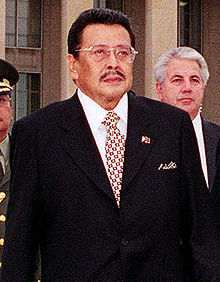Joseph Estrada | |
|---|---|
 Estrada in 2000 | |
| 13th President of the Philippines | |
| In office June 30, 1998 – January 20, 2001 | |
| Vice President | Gloria Macapagal Arroyo |
| Preceded by | Fidel V. Ramos |
| Succeeded by | Gloria Macapagal Arroyo |
| 9th Vice President of the Philippines | |
| In office June 30, 1992 – June 30, 1998 | |
| President | Fidel V. Ramos |
| Preceded by | Salvador Laurel |
| Succeeded by | Gloria Macapagal Arroyo |
| 22nd Mayor of Manila | |
| In office June 30, 2013 – June 30, 2019 | |
| Vice Mayor |
|
| Preceded by | Alfredo Lim |
| Succeeded by | Isko Moreno |
| 18th Secretary of the Interior and Local Government | |
| In office June 30, 1998 – April 12, 1999 | |
| President | Himself |
| Preceded by | Sonny Collantes (OIC) |
| Succeeded by | Ronaldo Puno |
| Chairman of the Presidential Anti-Crime Commission | |
| In office 1992–1997 | |
| President | Fidel V. Ramos |
| Senator of the Philippines | |
| In office June 30, 1987 – June 30, 1992 | |
| 14th Mayor of San Juan | |
| In office August 5, 1969 – March 26, 1986 | |
| Preceded by | Braulio Santo Domingo |
| Succeeded by | Reynaldo San Pascual |
| Personal details | |
| Born | Jose Marcelo Ejercito April 19, 1937 Tondo, Manila, Philippine Commonwealth |
| Political party | PMP (1991–present) |
| Other political affiliations |
|
| Spouse | |
| Children | 11 (incl. Jose Jr., Joseph Victor, Jude and Juan Emilio) |
| Relatives | Ejercito family |
| Residence | Santa Mesa, Manila |
| Alma mater | |
| Occupation |
|
| Profession | Businessman |
| Signature | |
| Criminal information | |
| Criminal status | Pardoned on October 26, 2007 by President Gloria Macapagal Arroyo |
| Criminal charge | Plunder |
| Penalty | Reclusión perpetua |
| ||
|---|---|---|
|
Early political career Mayor of San Juan
Senator of the Philippines
Vice President of the Philippines
Political affiliations
Public image
Post-Presidency
Elections
|
||
Joseph Ejercito Estrada KGCR (Tagalog: [ʔɛˌhɛːɾ.sɪˈto ʔɛsˈtɾaː.dɐ]; born Jose Marcelo Ejercito; April 19, 1937), also known by the nickname Erap,[1][a] is a Filipino politician and former actor, who served as the 13th President of the Philippines from 1998 until his removal in 2001, the 9th Vice President of the Philippines from 1992 to 1998, and the 22nd Mayor of Manila, the country's capital [2] from 2013 to 2019, also served as the 14th Mayor of San Juan from 1969 to 1986. In 2001, he became the first chief executive in Asia to be formally impeached.[3] At the age of 87, he is currently the oldest living former Philippine president.[citation needed]
Estrada gained popularity as a film actor, playing the lead role in over a hundred films in an acting career spanning some three decades. He also worked as a model, beginning as a fashion and ramp model at the age of 13. He used his popularity as an actor to make gains in politics, serving as the 14th Mayor of San Juan from 1969 to 1986, as Senator from 1987 to 1992, then as Vice President under President Fidel V. Ramos from 1992 to 1998.
Estrada was elected president in 1998 with a wide margin of votes separating him from the other challengers and was sworn into the presidency on June 30, 1998. In 2000, he declared an "all-out-war" against Moro Islamic Liberation Front and captured its headquarters and other camps.[4] Allegations of corruption spawned an impeachment trial in the Senate, and in 2001, Estrada was ousted in the Second EDSA Revolution after the prosecution walked out of the impeachment court when the senator-judges voted not to open an envelope that allegedly contained incriminating evidence against him. After his arrest on April 25, 2001, on charges of plunder, his supporters rallied and marched to Malacañang Palace and attempted to storm the premises in EDSA III.
In 2007, Estrada was sentenced by a special division of the Sandiganbayan to reclusión perpetua under a charge of plunder for the embezzlement of the $80 million from the government but was later granted a pardon by the president and his former deputy, Gloria Macapagal Arroyo. He ran for president again in the 2010 presidential election but was defeated by Senator Benigno Aquino III by a wide margin. He later served as the 22nd Mayor of Manila for two terms, from 2013 to 2019.
- ^ "Key facts on Philippines' former leader Estrada". Reuters. September 12, 2007. Retrieved November 16, 2020.
- ^ "Erap wins Manila mayoralty race – Election 2013, Special Reports". The Philippine Star. Archived from the original on June 7, 2013. Retrieved May 14, 2013.
- ^ Magno, Alexander R. (2001). "PHILIPPINES: Trauma of a Failed Presidency". Southeast Asian Affairs. 2001: 251–262. doi:10.1355/SEAA01P. JSTOR 27912279.
- ^ "Philippine Military Takes Moro Headquarters". People's Daily. July 10, 2000. Archived from the original on August 13, 2011. Retrieved October 12, 2011.
Cite error: There are <ref group=lower-alpha> tags or {{efn}} templates on this page, but the references will not show without a {{reflist|group=lower-alpha}} template or {{notelist}} template (see the help page).
